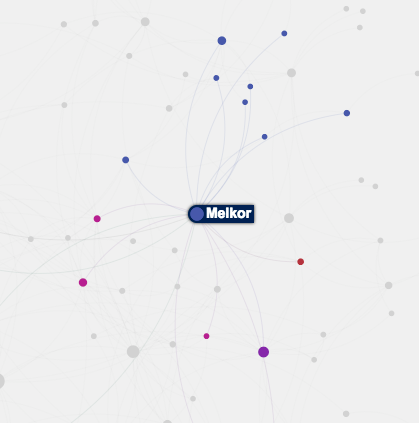Publications
Jing, E., Dedeo, S., & Ahn, Y. (n.d.). Sameness Attract, Novelty Disturbs, but Outliers Flourish in Fanfiction Online. arXiv preprint arXiv:1904.07741.
Park, J., Wood, I.D., Jing, E., Nematzadeh, A., Ghosh, S., Conover, M., & Ahn, Y. (2019). Global labor flow network reveals the hierarchical organization and dynamics of geo-industrial clusters in the world economy. Nature communications 10 (1), 1-10.
Ma, J., Jing, E., & Han, J. (2017). Predicting Mission Alignment and Preventing Mission Drift: How Revenue Sources Matter?. doi:/10.2139/ssrn.2915677.
Other projects
Character Interaction Networks in Movies

This project was done when I was at the 2016 Complex Systems Summer School hosted by the Santa Fe Institute. Using a unique dataset of Hollywood movies, we constructed character interaction networks in each movie based on the characters' co-appearance on screen. We found that the features of these networks reliably predicts genre and other film attributes, such as critical reception.
We also used the data to characterize how gender roles in movies have evolved over the last 50 years. Our analysis show that different statistical attributes (e.g., network centrality, screen time) are equalizing at vastly different rates, and that full gender equalization will take >80 years if current trends continue.
Because of a data sharing permission issue, we chose not to publish the results from this project. A draft can be viewed here.
The Philosophy of AI and Mind
The ultimate goal of AI researchers is to create machines with intelligence that equals to, or surpasses, human mind. However, the approaches to this goal are never uniform. Shall we create AI by simulating the human mind? Nowadays, most researchers in AI are not very interested in how the mind works, and the mainstream approaches to AI do not intentionally simulate humans' cognitive processes; similarities, if exist, are on an abstract level. However, there are still some heretics that insist on building "real" AI by making it work like the human minds do.
I had a chance to explore this topic in the very cool course with Professor Colin Allen. The outcome is a review paper that can be viewed here.
A Network approach to The Silmarillion

There has been some studies on the social networks of mythological narratives, and as a fan of J.R.R.Tolkien’s Middle-Earth, I decided to do a leisure-time project with his posthumous work The Silmarillion. A social network was constructed from the book based on the character's interpersonal relations. Analysis found typical features of an artificial social network. More interestingly, it was found that character-wise, a higher centrality in the network is a positive indicator of the character's popularity among fans, e.g., appearing in more fanfictions.
Cooperative Games in an Extended Lattice Gas Model
The formation of cooperation is a classical topic in evolutionary game theory. This project simulates a game between two species on an extended lattice gas model, with parameters including the species’ birth rates, death rates, and the benefits and costs of cooperation. The results of the simulation are passed to a replicator equation in order to study the choice of cooperation of individuals with the ability of learning. We show that the choice of cooperation is influenced both by the environmental parameters, and the benefts and costs of cooperation. If certain conditions are met, choosing cooperation can become the evolutionary stable strategy.
This research is my thesis for my major in Information Science. The thesis can be found here. (Note: content in Chinese)
Religious Practices in Interethnic Families in North Tibet-Yi Corridor

Religious difference is an important factor in the formation of marriages. It is traditionally believed that religious differences has a negative effect on the formation of interethnic marriages; and in existing interethnic families, these differences generally persist. However, our research found that religious difference doesn’t act as a key factor that prevents the marriage of two individuals from different ethnic groups; and in existing interethnic families, a mechanism is established to recognize and resolves such differences. As a result, interethnic families develop a reshaped "habitus" marked by a special set of values, attitudes and life style influenced by their merged spirituality.
This research is my thesis for my major in Anthropology. The paper can be viewed here.